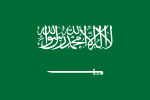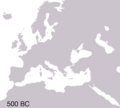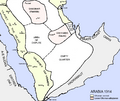History of Saudi Arabia facts for kids
settlements had always existed around oases; these are places in the deserts where growth and water are available.
Saudi Arabia became an important center, as Islam rose in the 620s. The cities of Medina and Mecca became the holiest places of Islam. They also became the two holiest cities for the Muslims in the whole world. The rulers and kings of Saudi Arabia also got more power.
Contents
Modern history
Background
The beginning of the modern history of Saudi Arabia was when an Islamic reformer named Muhammad ibn Abd al Wahhab and a local ruler named Muhammad bin Saud founded the Saudi state in the year 1744. It was founded in the central part of the Arabia. Over the next Century and a half, the Saud family saw bad and good times. The family also faced opposition from rulers of Egypt and the Ottoman Empire. The family also faced opposition from other powerful families of Arabia
Finally after many decades,The modern state of Saudi Arabia could be established by King Abdul Aziz Al-Saud (also known as Abdul Aziz Ibn Saud). In 1902, he took over the city of Riyadh from another family, named Al-Rashid. He continued to win more areas, and on 8 January 1926, he became the King of Hijaz. On 29 January 1927, he took the title of King of Nejd. On 20th May 1927, the government of the United Kingdom accepted him as the King of the areas ruled by him. His kingdom now became a sovereignty. All the regions under his control were united to form the state of Saudi Arabia by the year 1932. Petroleum oil was found in Saudi Arabia on 3 March 1938, which made the country rich as export of oil started to bring a lot of money.
Boundaries
Saudi Arabia discussed from the beginning of the 1920s with its neighboring countries about fixing of definite boundaries. It finalized its boundaries with Iraq, Jordan, and Kuwait. On borders with Iraq and Kuwait, two neutral zones were created – one with Iraq, and the other one with Kuwait. In 1934, borders with Yemen were almost finalized.
In 1965, Saudi Arabia gave some of its areas to Jordan, and Jordan gave some of its areas to Saudi Area. In 1971, the neutral zone between Saudi Arabia and Kuwait was partitioned between these two countries. Likewise, Saudi Arabia and Iraq decided in 1981 to partition the neutral zone between them. The zone was partitioned between the two countries in 1984.
Still, Saudi Arabia's borders with the United Arab Emirates and Oman are not final. The border with Qatar was finalized in 2001.
Politics
King Abdul Aziz Al-Saud died in 1953. His son named Saud became the king. He reigned for 11 years. In 1964, he was forced to step down, and his half-brother, Faisal, became the king. Faisal had the support of the senior members of the royal family and the religious leaders. Faisal also held the post of the Prime Minister. This tradition of being both the King and the Prime Minister still continues in Saudi Arabia. All Kings after Faisal had followed this practice.
Faisal took a number of new steps for economic development of Saudi Arabia. During his reign, many important political events also happened like the ones noted below:
- Differences between Saudi Arabia and Egypt over Yemen: Egypt supported the new government of Yemen, while Saudi Arabia supported the royal family of Yemen to continue in power.
- The Six-Day (Arab-Israeli) War of June 1967: Saudi Arabia did not directly fight in this war. But, after the war, it provided financial support to Egypt, Syria, and Jordan.
- Stopping of supply of oil to the USA and the Netherlands: In 1973, many countries stopped supplying petroleum oil to the USA and the Netherlands. Saudi Arabia was one of them.
In 1975, King Faisal was assassinated by one of his nephews. The nephew was found guilty, and he was sentenced to death. King Faisal's half-brother Khalid became the King and the Prime Minister of Saudi Arabia. During the reign of King Khalid, Saudi Arabia's importance in regional politics increased. The economic growth of the country also continued at a good rate.
King Fahd's period
King Khalid died in 1982. After his death, Fahd became the King. At the same time, he also became the Prime Minister of Saudi Arabia. His half-brother Prince Abdullah became the Crown Prince.
The income of Saudi Arabia became less during the period of King Fahd's reign. This was a result of lower price of petroleum oil. King Fahd's government used an economic policy which helped the country to survive with a lower income.
King Fahd helped Iraq during the Iran-Iraq war. Iraq's economy had become very bad on account of this war. The King also discussed with these two countries to stop war. Both countries (Iran and Iraq) stopped the war in August 1988,. The King also helped in making Gulf Cooperation Council (GCC) a stronger organization. The GCC is an organization of six countries of the Persian Gulf. The purpose of the organization is to increase development and cooperation among the member countries.
Gulf War
In 1990, Saddam Hussain was ruling Iraq. The Gulf War of 1991 was when he invaded Kuwait. Many people thought that his army would also invade Saudi Arabia. King Fahd allowed some Western countries and USA to send their forces to the country. Many Muslims were against that their most holy land was used by non-Muslim soldiers.
During and after the Gulf War, King Fahd’s role was very important. During the war, he allowed the entry of the royal family of Kuwait inside Saudi Arabia and followed by 400,000 other persons from Kuwait to stay on a temporary basis. The King allowed the troops of countries like USA to mount attacks on Kuwait to liberate it. He also helped in arranging support of other Muslim countries for liberation of Kuwait. Iraqi forces were eventually ousted from Kuwait.
Terrorism
Presence of troops from the Western countries has angered many Muslims. One of them was the rich man Osama bin Laden. He was forced to leave Saudi Arabia when he disagreed and opposed the King of Saudi Arabia. Other than Osma bin laden and his groups, there were several other persons and groups who did not like the presence of Western troops inside Saudi Arabia.
These persons and their groups attacked people, they tried manly to attack the foreign troops in Saudi Arabia. Some examples of such attacks are given below:
- A truck bomb killed 19 troops of the USA in June 1996.
- Bombing of a base of Saudi National Guard in November 1995.
September 11, 2001 attacks in New York had resulted into many deaths and big destruction. After enquiry, it came to light that out of 19 suspected persons for these attacks, 15 were from Saudi Arabia.
Such things attracted the attention of the government of Saudi Arabia. The government started a policy to check such activities. Even then, terrorist activities of such persons and groups continued.
Present position
- Death of King Fahd: He died in July 2005. After his death, his brother Prince Abdullah became the king.
- Death of King Abdullah: In 2015 King Abdullah died of sickness. His half-brother Prince Salman became king.
- Oil hub: Saudi Arabia has world's largest oil reserves. The government is giving a lot of importance to the developments of infrastructure, science, and technology. Many economists and other scholars think that the country is on its way to becoming leading country of the Middle East.
Related pages
Images for kids
-
The tribes of Arabia at the time of the spread of Islam (expandable map)
-
The first Saudi State 1744–1818
-
Abdulaziz Al Saud, founder of Saudi Arabia
See also
 In Spanish: Historia de Arabia Saudita para niños
In Spanish: Historia de Arabia Saudita para niños









